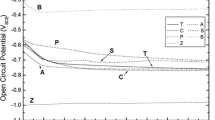Abstract
This paper presents an investigation on the corrosion behavior of five solders by means of polarization and electrochemical impedance spectroscopy (EIS) measurements. The Sn–9Zn and Sn–8Zn–3Bi solder, in comparison with the Sn–3.5Ag–0.5Cu and Sn–3.5Ag–0.5Cu–9In solder, were tested in 3.5 wt% NaCl solution and 0.1 wt% adipic acid solution, respectively. The Sn–37Pb solder was for reference in this work. The polarization curves indicated that the Sn–9Zn and Sn–8Zn–3Bi solder showed the worst corrosion resistance both in the salt and acid solutions, in terms of corrosion-current density, corrosion potential, linear polarization resistance, and passivation-current density. Meanwhile, the Sn–3.5Ag–0.5Cu solder remained the best corrosion characteristics in both solutions. It was found that due to microstructure alteration, Bi additive to the Sn–9Zn solder improved the corrosion behavior in the salt solution, whereas decreased that in the acid solution. However, the additive of In degraded the Sn–3.5Ag–0.5Cu solder in both solutions. The EIS results agreed well with the noble sequence of the five solders subjected to the two solutions with polarization. The equivalent circuits were also determined. Nevertheless, the four Pb-free solders exhibited acceptable corrosion properties since there was not much difference of key corrosion parameters between them and the Sn–37Pb solder.
Similar content being viewed by others
References
J.S. Hwang: Environment-Friendly Electronics: Lead-Free Technology (Electrochemical Publications Ltd., U.K., 2001).
M. Abtew and G. Selvaduray: Lead-free solders in microelectronics. Mater. Sci. Eng. Rep. 27, 95 (2000).
C.M.L. Wu, D.Q. Yu, C.M.T. Law and L. Wang: The properties of Sn–9Zn lead-free solder alloys doped with trace rare element. J. Electron. Mater. 31, 921 (2002).
K.L. Lin and T.P. Liu: High-temperature oxidation of a Sn–Zn–Al solder. Oxid. Metals 50, 255 (1998).
R.K. Shiue, L.W. Tsay, C.L. Lin and J.L. Ou: The reliability study of selected Sn-Zn based lead-free solders on Au/Ni–P/Cu substrate. Microelectron. Reliab. 43, 453 (2003).
M. Mori, K. Miura, T. Sasaki and T. Ohtsuka: Corrosion of tin alloys in sulfuric and nitric acids. Corros. Sci. 44, 887 (2002).
H. Oulfajrite, A. Sabbar, M. Boulghallat, A. Jouaiti, R. Lbibb and A. Zrineh: Electrochemical behavior of a new solder material Sn–In–Ag. Mater. Lett. 57, 4368 (2003).
K.L. Lin and T.P. Liu: The electrochemical corrosion behaviour of Pb-Free Al–Zn–Sn solders in NaCl solution. Mater. Chem. Phys. 56, 171 (1998).
K.L. Lin, F.C. Chung and T.P. Liu: The potentiodynamic polarization behavior of Pb-free XIn–9(5Al–Zn)–YSn solders. Mater. Chem. Phys. 53, 55 (1998).
J.H. Qiu: Polarisation Curves of Passivating Metals,www.ntu.edu.sg/home/asjqiu/me/ME303L11.HTM (accessed June, 2004).
Gamry Instruments, PA: Electrochemical Impedance Spectroscopy Primer,www.gamry.com/App_Notes/EIS_Primer/EIS_Primer.pdf (accessed July, 2005).
Corrosion Doctors’ Site Map: Polarization Diagram of a Passivable System,www.corrosion-doctors.org/index.htm (accessed February, 2004).
D.Q. Yu, C.M.L. Wu and L. Wang The electrochemical corrosion behavior of Sn-9Zn and Sn-8Zn-3Bi lead-free solder alloys in NaCl solution. 16th International Corrosion Congress on September 19–24, 2005, Beijing, P.R. China, 1408.
M.G. Fontana: Corrosion Engineering (McGraw-Hill, New York, 1986), pp. 499–502.
A.G. Munoz, S.B. Saidman and J.B. Bessone: Influence of In on the corrosion of Zn–In alloys. Corros. Sci. 43, 1245 (2001).
Author information
Authors and Affiliations
Corresponding author
Additional information
Address all correspondence to this author.
Rights and permissions
About this article
Cite this article
Wu, B.Y., Chan, Y.C., Alam, M.O. et al. Electrochemical corrosion study of Pb-free solders. Journal of Materials Research 21, 62–70 (2006). https://doi.org/10.1557/jmr.2006.0035
Received:
Accepted:
Published:
Issue Date:
DOI: https://doi.org/10.1557/jmr.2006.0035




